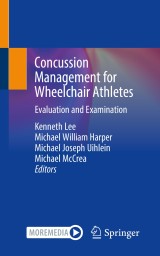Details

Concussion Management for Wheelchair Athletes
Evaluation and Examination|
85,59 € |
|
| Verlag: | Springer |
| Format: | |
| Veröffentl.: | 18.11.2021 |
| ISBN/EAN: | 9783030830045 |
| Sprache: | englisch |
| Anzahl Seiten: | 227 |
Dieses eBook enthält ein Wasserzeichen.
Beschreibungen
This book arises from the challenges and difficulties involved in the evaluation and management of concussions in wheelchair athletes. Concussions are most readily identified in the ambulatory population via identifying gross motor instability or when athletes lose their balance and stumble after a blow to the head or neck region. Because wheelchair athletes participate in sport while sitting down and using a wheelchair, clinicians must be extra attentive to identify a potential concussion. Once a potential concussion is identified, there are many challenges in evaluation of the wheelchair athlete population due to their comorbidities. At baseline, they may have signs and symptoms that mimic a concussion, and their impairments can also alter their cognitive and balance assessments. Therefore, it is critical to make a distinction between these athletes’ baseline comorbid impairments and potential new exam findings in a concussion. <div><br></div><div>Filling in a critical gap in the literature, this is a concise pocket guide for any clinician, trainer, or rehabilitation specialist who is involved in wheelchair sports. It focuses on the unique challenges in evaluating a concussion in the wheelchair athlete, including baseline testing, the process of evaluating the signs and symptoms of a concussion, cognitive and vestibular examination, new clinical techniques specific to wheelchair athletes, and the return to play process. A Concussion Management Program (CMP) for use on the sideline as well as in the office is included. </div><div><br></div><div>Practical and timely, <i>Concussion Management for Wheelchair Athletes</i> is a valuable resource to increase awareness, provide guidance on the unique challenges within this population, and generate interest in future research and investigation.</div>
<div>Introduction.- Concussion Baseline Testing.- Evaluation of Signs and Symptoms.- The Cognitive Exam.- Balance Testing in Wheelchair Athletes.- Clinical Reaction Time.- Vestibular Examination.- Return to Play.- Future Areas of Interest.</div>
<div>Kenneth Lee, MD</div><div>Department of Physical Medicine and Rehabilitation</div><div>Medical College of Wisconsin</div><div>Milwaukee, WI</div><div>USA</div><div><br></div><div>Michael William Harper, MD, ATC</div><div>Department of Physical Medicine and Rehabilitation</div><div>Medical College of Wisconsin</div><div>Milwaukee, WI</div><div>USA</div><div><br></div><div>Michael Joseph Uihlein, MD</div><div>Department of Emergency Medicine</div><div>Medical College of Wisconsin</div><div>Milwaukee, WI</div><div>USA</div><div><br></div><div>Michael McCrea, PhD, ABPP</div><div>Department of Neurosurgery</div><div>Medical College of Wisconsin</div><div>Milwaukee, WI</div><div>USA</div><div><br></div>
This book arises from the challenges and difficulties involved in the evaluation and management of concussions in wheelchair athletes. Concussions are most readily identified in the ambulatory population via identifying gross motor instability or when athletes lose their balance and stumble after a blow to the head or neck region. Because wheelchair athletes participate in sport while sitting down and using a wheelchair, clinicians must be extra attentive to identify a potential concussion. Once a potential concussion is identified, there are many challenges in evaluation of the wheelchair athlete population due to their comorbidities. At baseline, they may have signs and symptoms that mimic a concussion, and their impairments can also alter their cognitive and balance assessments. Therefore, it is critical to make a distinction between these athletes’ baseline comorbid impairments and potential new exam findings in a concussion. <div><br></div><div>Filling in a critical gap in the literature, this is a concise pocket guide for any clinician, trainer, or rehabilitation specialist who is involved in wheelchair sports. It focuses on the unique challenges in evaluating a concussion in the wheelchair athlete, including baseline testing, the process of evaluating the signs and symptoms of a concussion, cognitive and vestibular examination, new clinical techniques specific to wheelchair athletes, and the return to play process. A Concussion Management Program (CMP) for use on the sideline as well as in the office is included. </div><br><div>Practical and timely, <i>Concussion Management for Wheelchair Athletes</i> is a valuable resource to increase awareness, provide guidance on the unique challenges within this population, and generate interest in future research and investigation.</div>
A practical, concise pocket guide on the evaluation of concussions in wheelchair athletes Presents current examination and evaluation techniques in detail, with an eye toward return to play Includes a Concussion Management Program (CMP)

















